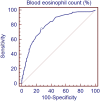Distribution of sputum cellular phenotype in a large asthma cohort: predicting factors for eosinophilic vs neutrophilic inflammation
- PMID: 23442497
- PMCID: PMC3657295
- DOI: 10.1186/1471-2466-13-11
Distribution of sputum cellular phenotype in a large asthma cohort: predicting factors for eosinophilic vs neutrophilic inflammation
Abstract
Background: Phenotyping asthma according to airway inflammation allows identification of responders to targeted therapy. Induced sputum is technically demanding. We aimed to identify predictors of sputum inflammatory phenotypes according to easily available clinical characteristics.
Methods: This retrospective study was conducted in 508 asthmatics with successful sputum induction recruited from the University Asthma Clinic of Liege. Receiver-operating characteristic (ROC) curve and multiple logistic regression analysis were used to assess the relationship between sputum eosinophil or neutrophil count and a set of covariates. Equations predicting sputum eosinophils and neutrophils were then validated in an independent group of asthmatics.
Results: Eosinophilic (≥3%) and neutrophilic (≥76%) airway inflammation were observed in 46% and 18% of patients respectively. Predictors of sputum eosinophilia ≥3% were high blood eosinophils, FENO and IgE level and low FEV1/FVC. The derived equation was validated with a Cohen's kappa coefficient of 0.59 (p < 0.0001). ROC curves showed a cut-off value of 220/mm3 (AUC = 0.79, p < 0.0001) or 3% (AUC = 0.81, p < 0.0001) for blood eosinophils to identify sputum eosinophilia ≥3%. Independent predictors of sputum neutrophilia were advanced age and high FRC but not blood neutrophil count.
Conclusion: Eosinophilic and paucigranulocytic asthma are the dominant inflammatory phenotypes. Blood eosinophils provide a practical alternative to predict sputum eosinophilia but sputum neutrophil count is poorly related to blood neutrophils.
Figures




References
-
- Green RH, Brightling CE, Woltmann G, Parker D, Wardlaw AJ, Pavord ID. Analysis of induced sputum in adults with asthma: identification of subgroup with isolated sputum neutrophilia and poor response to inhaled corticosteroids. Thorax. 2002;57(10):875–879. doi: 10.1136/thorax.57.10.875. - DOI - PMC - PubMed
Publication types
MeSH terms
Substances
LinkOut - more resources
Full Text Sources
Other Literature Sources
Medical

